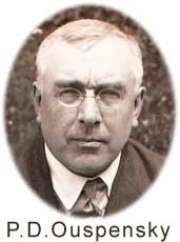|
Biografie P. D. Ouspensky
Peter D. Ouspensky (March 4, 1878–October 2, 1947), (Pyotr Demianovich Ouspenskii, also Uspenskii or Uspensky, Пётр Демья́нович Успе́нский), a Russian esotericist known for his expositions of the early work of the Greek-Armenian teacher of esoteric doctrine George Gurdjieff, whom he met in Moscow in 1915.
He was associated with the ideas and practices originating with Gurdjieff from then on. In 1924, he separated from Gurdjieff personally, and some, including Rodney Collin among others, say that he finally gave up the (Gurdjieff) "system" that he had shared with people for 25 years in England and the United States, but his own recorded words on the subject ("A Record of Meetings," published posthumously) do not clearly endorse this judgement nor does Ouspensky's emphasis on "you must make a new beginning" after confessing "I've left the system"; all this happened in Lyne Place, Surrey, England in 1947, just before his demise. While lecturing in London in 1924 he announced that he would continue independently the way he began in 1921. All in all, Ouspensky studied the Gurdjieff System directly under Gurdjieff's own supervision for a period of ten years, from 1915 to 1924. Ouspenky's book In Search of the Miraculous is a recounting of what Ouspensky learned from Gurdjieff during those years.[1]
CareerOuspensky was born in Moscow in 1878. In 1890, he was studying in the Second Moscow Gymnasium, a government school attended by boys from ten to eighteen. At the age of sixteen, he was expelled from school for painting graffiti on the wall in plain sight of a visiting inspector to see; thereafter, he would be more or less on his own.[2] In 1906, he was working in the editorial office of the Moscow daily paper The Morning. In the autumn of 1913, age 35, before the beginning of World War I, he journeyed to the East in search of the miraculous but returned to Moscow shortly after the beginning of the great world war. There he met Gurdjieff and took in Mme Sophie Grigorievna Maximenko as his wife but he had a mistress by the name of Anna Ilinishna Butkovsky.[3]
His first book, The Fourth Dimension, appeared in 1909; his second book, Tertium Organum, in 1912; and A New Model of the Universe in 1931. This last work discusses the idea of esotericism. He also wrote the novel Strange Life of Ivan Osokin, which explored the concept of recurrence or eternal return. He traveled in Europe and the East — India, Ceylon, and Egypt — in his search for knowledge. After his return to Russia and his introduction to Gurdjieff in 1915, Ouspensky spent the next few years studying with him. According to Osho, when Ouspensky went to Gurdjieff for the first time, the latter was but an unknown fakir and Ouspensky made him well-known to his own reading public.[4]
Denying the ultimate reality of motion in his book Tertium Organum,[5] he also negates Aristotle's Logical Formula of Identification of "A is A" and finally concludes in his "higher logic" that A is both A and not-A without specifying that in Aristotle's formula A can be both A and not A but not at the same time.[6]
Unbeknown to Ouspensky, a Russian émigré by the name of Nicholas Bessarabof took a copy of Tertium Organum to America and placed it in the hands of the architect Claude Bragdon who could read Russian and was interested in the fourth dimension.[7] Tertium Organum was rendered into English by Bragdon who had incorporated his own design of the hypercube[8][9] into the Rochester Chamber of Commerce building.[10] Bragdon also published the book and the publication was such a success that it was finally taken up by Alfred A. Knopf. At the time, in the early 1920s, Ouspensky's whereabouts were unknown until Bragdon located him in Constantinople and paid him some back royalties.
Ouspensky's lectures in London were attended by such literary figures as Aldous Huxley, T. S. Eliot, Gerald Heard and other writers, journalists and doctors. His influence on the literary scene of the 1920s and 1930s as well as on the Russian avant-garde was immense but still very little known.[11]
Ouspensky also provided an original discussion of the nature and expression of sexuality in his A New Model of the Universe; among other things, he draws a distinction between erotica and pornography.
During his years in Moscow, Ouspensky wrote for several newspapers and was particularly interested in the then-fashionable idea of the fourth dimension.[12] His first published work was titled The Fourth Dimension[13] and he explored the subject along the ideas prevalent at the time in the works of Charles H. Hinton,[14] the fourth dimension being an extension in space.[15][16] Ouspensky treats time as a fourth dimension only indirectly in a novel he wrote titled Strange Life of Ivan Osokin[17] where he also explores the theory of eternal recurrence.
|




